TURKISH ANGORA
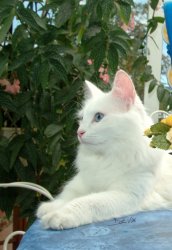
Vilmar' s
- The beautifulst cats of the photos are of the breeding
Vilmar' breeding s
GENERAL: the ideal Turkish Angora is a balanced, graceful cat with a fine, silky coat that shimmers with every movement, in contrast to the firm, long muscular body beneath it.
SUGGESTED BREEDINGS by MENANDPETS.COM
No breeding to signal
if you want to know like signaling yours, contacts: marketing@inseparabile.it
HEAD: Size: small to medium, in balance with the length of the body and extremities. Shape: a medium long, smooth wedge. Allowance is to be made for jowls. Profile: two planes formed by a flat top head and the line of the nose meeting at an angle slightly above the eyes. NO BREAK.
MUZZLE: a continuation of the smooth lines of the wedge with neither pronounced whisker pad nor pinch.
EARS: large, wide at base, pointed and tuffed. Set closely together, high on the head, vertical and erect.
EYES: large, almond-shaped, slanting slightly upward with open expression.
EYE COLOR: there is no relationship between eye color and coat color, and each eye color description can include much variation within its defined spectrum, especially as cats mature. Acceptable colors include blue, which encompasses shades from sky blue to sapphire; green, which can range from gooseberry to emerald; green-gold, which includes any gold or amber eye that carries a greenish cast or ring; amber, which can range from gold to rich copper but has no green cast or ring, and odd-eyed, with one blue eye and the other green, green-gold or amber. While no points are specifically allocated to eye color, deeper, richer tones are preferred. Odd-eyed cats should have similar depth of color in both eyes.
NOSE: medium in length.
NECK: slim, graceful and rather long.
CHIN: firm, gently rounded. Tip in profile to form perpendicular line with nose.
BODY: medium size, however, overall balance, grace and fineness of bone are more important than actual size. Males may be slightly larger than females. Body is long and slender, possessing greater depth than width, oval rather than round (not tubular). Shoulders the same width as hips. Rump slightly higher than shoulders. Finely boned with firm muscularity.
LEGS: long. Hind legs longer than front.
PAWS: small, round and dainty. Tufts between toes preferable.
TAIL: long and tapering from a wide base to a narrow end, with a full brush.
COAT: single coated. Length of body coat varies, but tail and ruff should be long, full, finely textured and have a silk-like sheen. "Britches" should be apparent on the hind legs.
BALANCE: proportionate in all physical aspects with a graceful, lithe appearance.
PENALIZE: obviously oversized, coarse appearance.
DISQUALIFY: cobby body type. Kinked or abnormal tail. Crossed eyes.
TURKISH ANGORA COLORS
WHITE: pure white, no other coloring. Nose leather and paw pads: pink.
BLACK: dense coal black, sound from roots to tip of fur. Free from any tinge of rust on tips or smoke undercoat. Nose leather: black. Paw pads: black or brown.
BLUE: blue, lighter shade preferred. One level tone from nose to tip of tail. Sound to the roots. A sound darker shade is more acceptable than an unsound lighter shade. Nose leather and paw pads: blue.
CREAM: one level shade of buff cream without markings. Sound to the roots. Lighter shades preferred. Nose leather and paw pads: pink.
RED: deep, rich, clear, brilliant red; without shading, markings, or ticking. Lips and chin the same color as coat. Nose leather and paw pads: brick red.
Note: tabby markings are frequently present on younger smokes and should not be penalized in those under 1 year of age.
CLASSIC TABBY PATTERN: markings dense, clearly defined, and broad. Legs evenly barred with bracelets coming up to meet the body markings. Tail evenly ringed. Several unbroken necklaces on neck and upper chest, the more the better. Frown marks on forehead form an intricate letter "M." Unbroken line runs back from outer corner of eye. Swirls on cheeks. Vertical lines over back of head extend to shoulder markings which are in the shape of a butterfly with both upper and lower wings distinctly outlined and marked with dots inside outline. Back markings consist of a vertical line down the spine from butterfly to tail with a vertical stripe paralleling it on each side, the three stripes well separated by stripes of the ground color. Large solid blotch on each side to be encircled by one or more unbroken rings. Side markings should be the same on both sides. Double vertical rows of buttons on chest and stomach.
MACKEREL TABBY PATTERN: markings dense, clearly defined, and all narrow pencillings. Legs evenly barred with narrow bracelets coming up to meet the body markings. Tail barred. Necklaces on neck and chest distinct, like so many chains. Head barred with an "M" on the forehead. Unbroken lines running back from the eyes. Lines running down the head to meet the shoulders. Spine lines run together to form a narrow saddle. Narrow pencillings run around body.
SPOTTED TABBY PATTERN: markings on the body to be spotted. May vary in size and shape with preference given to round, evenly distributed spots. Spots should not run together in a broken mackerel pattern. A dorsal stripe runs the length of the body to the tip of the tail. The stripe is ideally composed of spots. The markings on the face and forehead shall be characteristic tabby markings. Lips and chin the same shade as the rings around the eyes. The belly should have "vest buttons". Legs and tail are barred.
PATCHED TABBY PATTERN: a patched tabby (torbie) is an established silver, blue-silver, brown or blue tabby with patches of red or cream.
SILVER TABBY (classic, mackerel, spotted): ground color pale clear silver. Markings dense black. Lips and chin the same shade as the rings around the eyes. Nose leather: brick red. Paw pads: black.
RED TABBY (classic, mackerel, spotted): ground color red. Markings deep rich red. Lips and chin the same shade as the rings around the eyes. Nose leather and paw pads: brick red.
BROWN TABBY (classic, mackerel, spotted): ground color brilliant coppery brown. Markings dense black. Lips and chin the same shade as the rings around the eyes. Back of leg black from paw to heel. Nose leather: brick red. Paw pads: black or brown.
BLUE TABBY (classic, mackerel, spotted): ground color pale bluish ivory. Markings a very deep blue affording a good contrast with ground color. Lips and chin the same shade as the rings around the eyes. Warm fawn overtones or patina over the whole. Nose leather: old rose. Paw pads: rose.
CREAM TABBY (classic, mackerel, spotted): ground color very pale cream. Markings of buff or cream sufficiently darker than the ground color to afford good contrast but remaining within the dilute color range. Lips and chin the same shade as the rings around the eyes. Nose leather and paw pads: pink.
CAMEO TABBY (classic, mackerel, spotted): ground color off-white. Markings red. Lips and chin the same shade as the rings around the eyes. Nose leather and paw pads: rose desirable.
CREAM CAMEO TABBY (Cream Silver) (classic, mackerel, spotted): ground color off-white. Markings cream. Lips and chin the same shade as the rings around the eyes. Nose leather and paw pads: pink.
BLUE-SILVER TABBY (classic, mackerel, spotted): ground color pale, bluish silver. Markings a deep blue affording a good contrast with ground color. Lips and chin the same shade as the rings around the eyes. Nose leather: old rose desirable. Paw pads: rose desirable.
BLUE SILVER PATCHED TABBY (classic, mackerel, spotted): ground color pale bluish silver. Markings sound blue. Patches of cream tabby or softly intermingled areas of cream tabby on both body and extremities. Lips and chin the same shade as the rings around the eyes. Nose leather: blue or old rose trimmed with blue and/or pink. Paw pads: blue or old rose and/or pink.
TABBY AND WHITE (classic, mackerel, spotted and patched, where applicable): color as defined for tabby with or without white on the face. Must have white on bib, belly and all four paws. White on at least one-third of body and white blaze on face is desirable. Tabby colors accepted are brown, silver, blue, blue-silver, red, cream, cameo and cream-cameo.
TORTOISESHELL: black with patches of red or softly intermingled areas of red on both body and extremities. Presence of several shades of red acceptable. Nose leather and paw pads: black and/or brick red.
CALICO: white with distinct patches of black and red. Tabby markings are allowed in the red patches. White predominant on underparts.
DILUTE CALICO: white with distinct patches of blue and cream. Tabby markings are allowed in the cream patches. White predominant on underparts.
BLUE-CREAM: blue with patches of cream or softly intermingled areas of cream on both body and extremities. Lighter shades preferred. Nose leather and paw pads: blue and/or pink.
BLACK SMOKE: white basecoat, deeply tipped with black. Cat in repose appears black. In motion, the white basecoat is clearly apparent. Points and mask black with narrow band of white at base of hairs next to skin which may be seen only when fur is parted. Nose leather and paw pads: black.
BLUE SMOKE: white basecoat, deeply tipped with blue. Cat in repose appears blue. In motion the white basecoat is clearly apparent. Points and mask blue with narrow band of white at base of hairs next to skin which may be seen only when fur is parted. Nose leather and paw pads: blue.
CAMEO SMOKE (red smoke): white basecoat, deeply tipped with red. Cat in repose appears red. In motion, white basecoat is clearly apparent. Points and mask red with narrow band of white at base of hairs next to skin which may be seen only when fur is parted. Nose leather and paw pads: rose desirable.
CREAM CAMEO SMOKE (cream smoke): white basecoat, deeply tipped with cream. Cat in repose appears cream. In motion, white basecoat is clearly apparent. Points and mask cream with narrow band of white at base of hairs next to skin which may be seen only when fur is parted. Nose leather and paw pads: pink desirable.
BLUE-CREAM SMOKE: white basecoat, deeply tipped with blue and cream. Cat in repose appears blue-cream. In motion, white basecoat is clearly apparent. Points and mask blue-cream with narrow band of white at base of hairs next to skin which may be seen only when fur is parted. Nose leather and paw pads: rose pink or blue, may be patched.
TORTOISESHELL SMOKE: white basecoat, deeply tipped with black, red and shades of red. Cat in repose appears tortoiseshell. In motion, white basecoat is clearly apparent. Points and mask tortoiseshell pattern with narrow band of white at base of hairs next to skin which may be seen only when fur is parted. Nose leather and paw pads: rose pink or black, may be patched.
SHADED SILVER: undercoat white. Mantle of black shading down the sides, face, and tail, becoming paler on the chin, chest, stomach, and under the tail. Face and legs may have darker shading than the body. Black outlining on rims of eyes, lips and nose desirable. Nose leather: brick red. Paw pads: black.
BLUE SHADED SILVER: undercoat white. Mantle of blue shading down the sides, face, and tail, becoming paler on the chin, chest, stomach, and under the tail. Face and legs may have darker shading than the body. Blue outlining on rims of eyes, lips and nose desirable. Nose leather: rose. Paw pads: blue or rose.
CAMEO SHADED (red shaded): undercoat white. Mantle of red shading down the sides, face, and tail, becoming paler on the chin, chest, stomach, and under the tail. Face and legs may have darker shading than the body. Nose leather, rims of eyes and paw pads: rose.
CREAM CAMEO SHADED (cream shaded): undercoat white. Mantle of cream shading down the sides, face, and tail, becoming paler on the chin, chest, stomach, and under the tail. Face and legs may have darker shading than the body. Nose leather, rims of eyes and paw pads: rose.
TORTOISESHELL SHADED: undercoat white. Mantle of black and red shading down the sides, face and tail, becoming paler on the chin, chest, stomach, and under the tail. Face and legs may have darker shading than the body. Nose leather, rims of eyes and paw pads: rose to black, may also be patched.
BLUE-CREAM SHADED: undercoat white. Mantle of blue and cream shading down the sides, face and tail, becoming paler on the chin, chest, stomach, and under the tail. Face and legs may have darker shading than the body. Nose leather, rims of eyes and paw pads: rose pink to blue, may also be patched.
BI-COLOR: black and white, blue and white, red and white, or cream and white. White feet, legs, undersides, chest, and muzzle. Inverted "V" blaze on face desirable. White under tail and white collar allowable.
SMOKE AND WHITE: black smoke & white, blue smoke & white, cameo smoke (red smoke) & white, cream cameo smoke (cream smoke) & white. White with colored portions that conform to the currently established smoke color standards. White predominant on underparts.
CALICO SMOKE: white with patches of black and red. The black and red patches have a white undercoat. White predominant on underparts.
DILUTE CALICO SMOKE: white with patches of blue and cream. The blue and cream patches have a white undercoat. White predominant on underparts.
OTAC (Other Turkish Angora Colors): any other color or pattern with the exception of those showing hybridization resulting in the colors chocolate, lavender, the Himalayan pattern, or these combinations with white.
above the CFA Breed Standards
after automatic translate from inseparabile.com
The HISTORY.
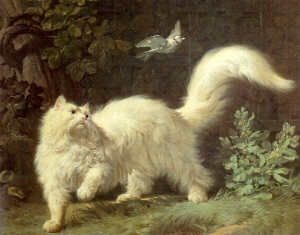
Every time that hill the eyes on a Turkish Angora, task of star admiring an old tapestry, a survivor...
Apprezzatissimo in its country of origin sin from 1400 and accommodated in many nobiliari real courts and salotti in Europe between 1600 and 1900, the Angora be to a step from the extinction at the beginning of XX the century. Only the farsightedness of the Turkish government has allowed this feline small to survive.
But we begin from the principle... The Turkish Angora was gi famous in Turkey in XV the century and wide was accommodated in resists of the sultani and in the rich dwellings of dignitaries and merchants. Many possessed some vary exemplary, in the devout ones disparati colors. The first sure news of the apparition of this race in Europe goes back to 1600, century in which of they Goes and the Peiresc of it imported the first exemplary. The happened one was immediate and this exotic micio divenne one fixed presence in the real courts and atelier nobiliari (the pack-saddles to think next to the famous Brilliant, Turkish Angora pertaining to the king sun). Beautifulst, fascinating and most precious divenne one status symbol to the point quite to be immortalato in pittoriche burlaps. Moreover its singolarit made it to earn a scientific name just: felis catus angoriensis. The happened one of this race in our continent protrae for three centuries, tant that to the first feline exposure to the Crystal Palace of London (the 1871) Turkish Angora has still an enormous one happening... the last one of its sfolgorante career. Little years after the denomination of Angora it comes narrow from the British Society to the single variet white woman, and finally in 1887 it comes launched a standard that preprefers the massive and rounded off type, typical of the variet Persian... The Turkish Angora comes then only devout used for the development of the Persian. The race to scompare then before from the English-speaking countries and pian slowly from the rest of Europe.
The Angora does not have a better fortune in its native land of origin, where a timely participation of the government made s that last the 30 exemplary of Turkish Angora white man came declare national treasure to you and came launched a program of protection and breeding in the zoo of Ankara. For tens of years it was not known devout null of this race, finch, in the years ' the 60 spouses Grant did not succeed to import in America one brace of cats from the zoo. The perseveranza of Grant port to the acknowledgment of the race between 1973 and 1978, opening cos the doors to the spread of the Turkish Angora.
The Angora Today
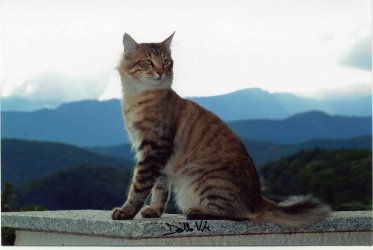
Vilmar' s
In the PHOTO The SAME SUBJECT IN SUMMER And WINTER
To our days the Turkish Angora still one and rather little known rare race, in spite of the effort of the European breeders and Americans. For how much the selection job has carried of the changes in the aspect of the race, exalting some the elegance and the lightness, the Turkish Angora modern anchor much similar one to its ancestors immortalati in the paintings and the designs of hundred of years ago.
The aspect.
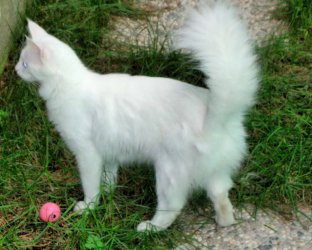
Vilmar' s
The Turkish Angora a longilineo and athletic animal, that it has incedere and the aspect of a classic dancer of dance. Its zampette long and thin is supported on round feet, the longilineo body (ahim does not have to make to fatten it!) and the thin neck makes of this animaletto something of only. The true one capolavoro for the musino (triangular and is lengthened, with a small nasino and two great occhioni to almond) that the world with interrogative air watches, the great always careful orecchie from which linceschi forelocks of hair appear and the tail... , the tail, that longest tail hairiest capacity to mo' of banner. A Turkish Angora that you respect yourself moves in one cloud of hair sericeo, and shining, medium-along, pressoch impalpabile and without sottopelo... insomma perfect tutu' of one the dancer. Although the variet devout she notices is the white man, the Angora pu to be pressoch of any color, excluded the colorpoint (siamesato), the chocolate and the lilac, that they are clear sign of hybridization with others breeds.
The character
The Turkish Angora the lively indeed liveliest cat, sprizza wants of living from every hair and ' rimbalza' with it knows to you and piroette GO BACK TO LIST every bug, little ball of paper or imaginary monster that the understood ones to shooting. Moreover most curious: absolutely impossible to introduce in house something - or someone - without that this is winnowed from its occhioni to almond and appuntito its nasino. A lot vivacit pu not to be accompanied from a atleticit remarkable, than I render it in a position to strabilianti leaps, and of acrobatics to the limit of the improbable one. Fortunately and good peace of all, the careful Turkish Angora, aggraziato and knows to dose its forces well. E' much difficult one that it damages something. Pu to seem strange but the Angora a cat much affectionate cake and. It encircles its landladies of infinite attentions, fused, strusciamenti and coccole, turning out sometimes invading. Moreover the ideal companion of the children, of which he divides curiosit and the vitalit, and with which demonstrates one worthy patience of the best ones baby-sitter.
The health and the cures
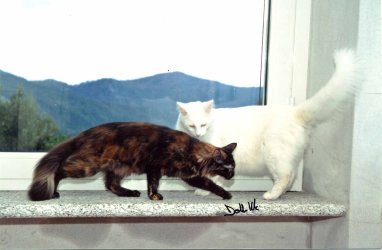
Vilmar' s
The Turkish Angora a spontaneous race, and in the how much such natural selection has rendered it sturdy and practical. This cat pu to boast one iron health, and one remarkable physical resistance. In order to maintain it R-al.meglio, to a balanced diet or housewife or manufacturer of high advisable wrap... but attention to the excesses, a golosone and stretches to fatten.
Although the hair along this micio does not have particular need of toelettaure: one beautiful brushed sufficient weekly magazine devout that for the greater part of the year. In the dumb period of of the better hair concedergli some spazzolatina in devout.
The white man and the sordit
Contrarily to how much the Turkish Angora is believed white man to blue eyes not always sordo, tuttaltro. The problem of sordit the legacy to the color white man (and therefore pu to be found in all the white men independently from the color of the eyes), and pu pressoch to be cancelled by means of a responsible breeding that it previews: - the control of the capacit auditory of the riproduttori white men by means of audiometrico test
- sterilization of the cats not hearing white men
- the single connection of cats white men and exclusively with cats colors to you.
The Turkish Angora in house
The Turkish Angora splendidly adapted to the life housewife, and the cohabitation with other domestic animals (that it commands to baton!). E' however a animaletto impegnativo that authoritarian demands the attention of its humans (piazzandoglisi on the shoulders, as an example) and stretches to make jealous a po' if neglected. Much affection for the master renders it the perfect companion of travel, ready to exceed any uneasiness also to maintain its role ' before donna'. The Turkish Angora sopporta the isolation and the physical limitation, the cages and the confinamento are absolutely from avoiding. In apartment this race does not have needs particular (coccole to part).
The Breeding
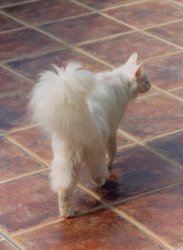
Vilmar' s
To raise Turkish Angora not exactly one walk. The Angora extension all its vivacit also in the issues lovings: the fanciulline exactly are not morigerate... in the period of the heat it must be put R-on account some night insonne. The maschietti they are not from less and they are a lot to use in signaling their presence to you. Moreover given the meager number of entire subjects long travels for reperire exemplary legacies from relationship often become necessary (indispensable in order not to safeguard the health of the generations future) or possible spasimanti. Exceeded all these avversit and considered the opportune precautions necessary to limit rebelling of the sordit in the puppys, us pu to enjoy the felicit one manciata of cucciolotti (from 2 to 7), very attended to and pasciuti from gatta mother. Fortunately nella overwhelming majority goddesses cases the gestations delle angorette do not give problems, cos like not of d the delivery, than of rule it happens sul read dell' human devout loved.
The ideal master
The future master of a Angora must be disposed to divide its existence with a cat ' primadonna'. It must put R-on account dividing all with he: the friends, the hobby, the potrone...
This card be donated to us from Breeding "1001 Night & Catal Hoyuk" riconosiuto ANFI-FIF and CFA www.angoraturco.it
|
|
On Inseparable |
|
|
In The Web |
. gatti
. piccoli mammiferi
. uccelli
. rettili
. anfibi
. pesci
. acqua temperata
. acqua tropicale
. pesci rossi
. piante acquario
. acqua marina
. invertebrati
. bovini
. cavalli
. suini
. capre
. pecore
. conigli
. galline
. anatre
|
. Pubblica gratis i tuoi annunci di animali domestici su trovapuppys.com |
|||
|